CONTENTS
Left-handed Catcher
Ugly Uniforms But Illegal?
18-inning Shutout
Traded for an Announcer
Last Browns' Game
Nothing But Slow Curves
Score That 1-2-7-6-7
Zeke Steals Home
Steve Bartman: Cub Enemy #1
Even the Greats Lost Money
Baseball Lore –
I
Baseball Lore – II
Baseball
Lore – IV
Baseball
Lore – V
Baseball
Lore – VI
Baseball
Lore – VII
Baseball
Lore – VIII
Baseball
Lore – IX
Baseball
Lore – X
Baseball
Magazine
Top of Page
|
Bits
of Baseball Lore – III
Dale Long is best known for hitting HRs in eight straight games (May 19-28) for the Pittsburgh Pirates during the 1956 season.
- Dale broke the previous mark of six held by five players, the last of whom was Willie Mays.
- Long's mark has since been tied by Don Mattingly (1987) and Ken Griffey, Jr. (1993).
However, Dale achieved another distinction as a defensive player.
- Playing for the Cubs in 1958, Long became the first left-handed C since 1905. He did so in two games. In both cases, he shifted from 1B to C in the ninth inning.
- Chicago manager Bob Scheffing pressed Dale into service as his backstop in the first game of a DH vs his old team, the Pirates, at Wrigley Field on August 20. Long used his first baseman's mitt to catch RHP Don Elston for 1/3 of an inning and lefty Bill Henry for 2/3 in the 4-2 loss.
- Long again took over the C position on September 21 in a 2-1 loss at The Friendly Confines against the Dodgers (in their first year in Los Angeles). This time he employed a left-handed catcher's mitt to receive Elston's deliveries.
Two other players have since caught left-handed in the big leagues.
- Mike Squires did so for the Chicago White Sox in two games in 1980.
- in 1989, Bennie DiStefano caught three southpaw games for the Pirates.
Final note: Dale Long played the 1952 season for the New Orleans Pelicans of the AA Southern Association.
|
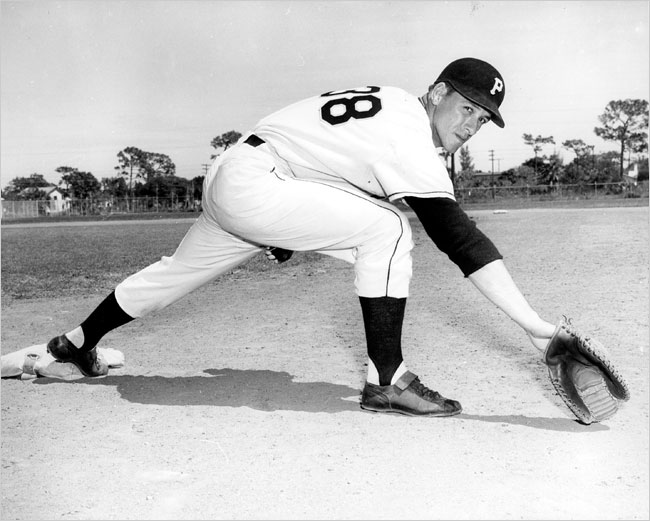
Dale Long, Pirates

Dale Long, Cubs |
Ugly Uniforms But Illegal?
The 1976 Chicago White Sox of new owner Bill Veeck sported some of the most controversial uniforms in MLB history. Taking over a team that finished 75-86 in '75, Veeck applied his famous promotional skills to generate some excitement for the new season.
On March 4, Veeck held one of his famous impromptu press conferences at a pub in Chicago.
- Rumors had already circulated that the Sox would wear new uniforms. So writers grilled Veeck on that subject.
- "We are adding elegance to baseball styles," the owner replied. "We may not be the greatest team in baseball, at least not for a few years, but we'll immediately be the most stylish team in the game."
- Reminded that Charley Finley's Oakland A's had already departed from the traditional white and gray shirts and pants, Bill remarked, "The White Sox are not going to be dressed like a bunch of peacocks. There is a difference between color and elegance ... You will be awed ... Comiskey Park will replace Paris and New York as the fashion center of the World."
- One questioner asked, "Are you going to have the White Sox wearing shorts ... like the Hollywood Stars used to wear?" Bill: "We don't borrow ideas from anyone. However, I believe safety may rule out shorts ... and panty hose."
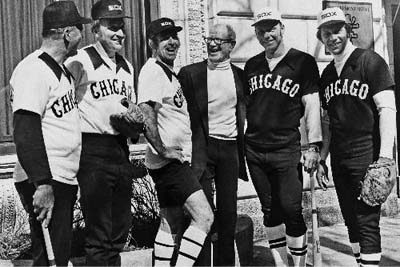
1976 White Sox players with owner Bill Veeck
When unveiled, the uniforms were not colorful, just navy and white. But they were different, reminding some of uniforms from the first decade of the 20th century.
When the White Sox visited refurbished Yankee Stadium for the first time in the 1976 season on April 20, New York manager Billy Martin questioned whether the uniforms were entirely legal.
- Specifically, Billy thought there must be something in the rules against white undershirts, especially if worn by a P.
- Martin lodged a protest with Umpire Marty Springstead, who agreed with Billy but wasn't sure.
- Since it was too late to check with the AL office, Springstead ordered Sox P Bart Johnson to remove the white sleeve on his shirt. After the repair was made with a scissors, Johnson continued on the mound. He gave up five Yankee runs in only two innings.
- Before Clay Carroll relieved in the third, he replaced his white shirt with a blue one.
- When the Yankees won 5-4, Chicago manager Paul Richards protested the game.
- AL president Lee MacPhail ruled that the white shirts were acceptable but allowed the outcome of the contest to stand.
The uniforms included one set with shorts.
- The shorts were worn only once, during the first half of a DH on August 8, 1976, against Kansas City.
- Royals 1B John Mayberry told his opponents, "You guys are the sweetest team we've seen yet."
- The Sox won the game 5-2 with four steals (and four skinned knees?).
- Chicago ditched the uniforms for the second game and never donned them again.
- The White Sox lost the second game 7-1 and compiled a 24-37 record the rest of the season.
Reference: The Rules and Lore of Baseball, Rich Marazzi | Top of Page |
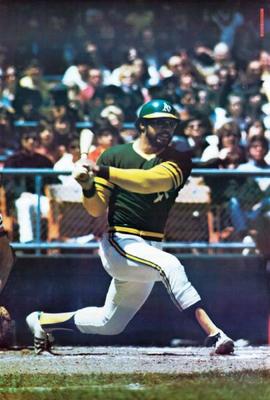
Oakland A's uniforms
|
August
17, 1882: In one of the classic games of the 19th century,
the Providence Grays defeated
the Detroit Wolverines
1-0 in 18 innings in a National League game in Providence.
- The winning
blow was a HR by RF Charles
"Old Hoss" Radbourn, who is in the Hall of Fame
as a pitcher.
- Both starting pitchers, winner Montgomery
Ward (another future Hall of Famer but as a shortstop)
and loser Stump Weidman, went the distance.
- Providence almost won in the 16th when George
Wright "hit a liner over Wood's head
and out of the horse gate, but Wood went outside, got
the ball and fielded Wright out at the plate"
(Detroit Free Press).
- Wright had played for the first
"openly professional" team, the Cincinnati
Red Stockings, in 1869. He is in the HOF as an executive/pioneer.
His brother Harry was manager of the Grays who finished second that season to the Chicago
White Stockings.
- Detroit finished sixth in the eight-team league.
- This game ranked as the longest
shutout in ML history until September 1, 1967, when San
Francisco blanked Cincinnati 1-0 in 20 innings.
|
Hall
of Fame broadcaster Ernie Harwell is the only announcer
who ever figured in a baseball trade. In 1948, Ernie
was play-by-play man for the Atlanta Crackers of the
AA Southern Association. Branch Rickey, General Manager
of the Brooklyn Dodgers,
needed someone to fill in for his lead announcer, Red Barber
(another future Hall of Famer), who was recovering from a perforated
ulcer. When Rickey asked Earl Mann,
President of the Crackers, about the availability of
Harwell, Mann saw the chance to drive
a bargain. He would let Harwell go to Brooklyn
if Rickey sent Montreal C Cliff
Dapper to Atlanta to manage the club. Rickey
agreed and the rest is history. Ernie made his MLB
debut on August 4 as the Dodgers
beat the Cubs at Ebbets
Field 5-4.
Harwell
moved across town to the New York Giants
and was part of the broadcast team with Russ Hodges
that called the famous third game of the 1951 playoff won by Bobby
Thomson's HR. Harwell eventually became the
lead announcer in Baltimore
and, in 1960, went to Detroit
where he spent the rest of his career calling Tiger
games. He was inducted into Cooperstown in 1982. He retired in 2002,
although he had been forced out for one year by Tiger
management in 1992 in what has been called "the most ridiculed
firing in broadcasting history." He was restored the following
year after fans refused to embrace the younger announcing team.
|
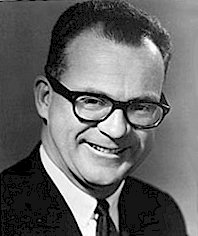
Ernie Harwell |
On
Sunday, September 27, 1953, the St. Louis Browns played
their last game at Sportsman's Park. Unable to compete with the Cardinals
despite making Card hero
Marty Marion his manager, owner Bill
Veeck wanted to move the team. However, he had so alienated
the other AL owners that they told him he had to sell the team before
they would agree to a move. The team would begin the 1954 season as
the Baltimore Orioles.
3,174 gathered for the finale against the Chicago
White Sox. This may not seem like much of a crowd for
the final game, but it topped the 2,068 that had attended Friday night
and Saturday's 1,937. (This brought the total attendance for the entire
year to 297,238, which was about one-third of the league average.) The
game went into extra innings. When plate umpire Art Passarella called for fresh baseballs, he was told that the supply was exhausted.
Facing the possibility of having to call the game, Passarella picked out the least damaged balls that had previously been thrown out
during the game. Unfortunately for the home team the game continued,
and the White Sox won
2-1 to complete a sweep of the three-game series. The Browns lost their 100th game to finish last (8th), 46.5 games behind the champion Yankees.
|
 |
Bill
"Spaceman" Lee tells this story in his book Baseball
Eccentrics. He was pitching for the Red
Sox against the White Sox in a driving
rain. Lee decided to throw nothing but slow curveballs,
figuring that the hitters would have to look up into the rain and blink.
After 14 straight slow curves, both managers started yelling at him.
- Chicago's Chuck Tanner: "You
son of a bitch, quit showing up my hitters!"
- Lee's
own manager, Eddie Kasko: "You can't throw that
many curveballs in a row!"
The last out of the game was recorded
by Bill Melton, who hit a line drive off Lee's
chest. He dropped down to pick it up and threw under his arm to first
for the out. This left him lying in the soggy infield grass. He got
a standing ovation for a complete game win in which he threw nothing
but slow curves the last three innings.
|
April
25, 1970: Tigers @ Twins
at Metropolitan Stadium, Bloomington MN. 7th inning. 2 outs. None on.
Tiger pitcher Earl
Wilson at bat. Wilson strikes out. However,
3B coach Grover Resigner, noticing that Twin C Paul Ratliff trapped the ball, told Wilson to run to first since Ratliff didn't tag him or throw
to first. Instead Ratliff rolled the ball back to mound.
(Like Angel C Josh
Paul when the White Sox's A.J. Pierzynski struck out in the 2005 AL Championship Series.) Most of the Twins left the field when Wilson
starts running. So he races around the bases and turns for home when
LF Brant Alyea, on his way to the dugout, retrieves
the ball and throws to SS Leo Cardenas at the plate.
Wilson puts on the brakes and tries to get back to
third but Alyea beats him to the bag and takes Cardenas'
peg in time to tag out Wilson. So the play goes 1-2-7-6-7.
Reference:
Baseball
Digest, August 2007 |
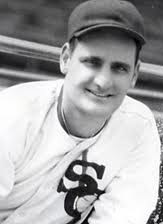
Zeke Bonura |
First
paragraph of the New York Times article about an August 27,
1935, doubleheader:
The Yankees fought their
longest battle of the year today before 15,000 fans at Comiskey Park
and lost to the White Sox. In the fifteenth inning
of the first game in their second straight double-header here, the slow-footed Zeke Bonura summoned an amazing burst of speed when
he caught Jimmy De Shong in the midst of a long wind-up
and stole home with the run that won for the Sox, 9
to 8.
The
210-pound Bonura stole all of four bases for Chicago that season (and 19 in his seven years in the bigs). Zeke had established himself as the White Sox first bona-fide
HR hitter with a club-record 27 in his rookie season in 1934 and then
21 in 1935. However, his cavalier attitude toward fielding at 1B soured
Manager Jimmy Dykes on him, and Zeke was traded to Washington for the 1938 season.
As
a 16-year-old student at St. Stanislaus College in
Bay St. Louis MS, Zeke had won the 1925 National AAU
Championship in the Javelin with a record throw of 65.18 meters. Although
his distance record has long been surpassed, he remains the youngest
person ever to win an event at the National Track & Field Championship
Meet.
|
|
Several
players have been suspended for 30 days for their actions on the field
(not illegal drug use). Some examples:
-
Bill
Dickey of the New York Yankees was
quiet off the field but very competitive behind the plate. On July
4, 1932 he broke the jaw of the Senators' Carl
Reynolds with one punch after a collision at home plate.
William Harridge, AL President, suspended Dickey
for 30 days and fined him $1,000. When Dickey returned
on August 4, he hit a grand slam and three singles as the Yankees
clobbered the Chicago White Sox 15-3.
-
One
of Dickey's teammates was suspended ten years later.
In the ninth inning of Game 3 of the 1942 World Series, Frank
Crosetti, angry at being called out at third by Bill
Summers, accosted the umpire and pushed both hands into
his stomach. Summers pushed the smaller Yankee
right back. Crosetti wasn't ejected because Commissioner
Landis had asked umpires to be sensitive to wartime manpower
shortages. However, Frank was fined $250 and suspended
for the first 30 days of the 1943 season.
-
Crosetti
returned to the New York lineup May 21, 1943. Eight
days later, Dodgers
pitcher Johnny Allen, incensed over a balk call,
grabbed umpire George Barr by the shoulders. NL
President Ford Frick fined Allen
$200 and gave him 30 days off.
|
Steve Bartman: Cub Enemy #1
Perhaps
the most famous incident involving a fan occurred in the 8th inning of
Game 6 of the 2003 National League Championship Series. We're talking
about Steve Bartman's innocently reaching for a foul
ball down the LF line at Wrigley Field and preventing (supposedly) Moises
Alou from catching it. Gene Wojciechowski writes
about it in the tenth anniversary issue of ESPN the Magazine.
- "The
whole situation was so Cubs." Chicago
led Florida 3-2 in games
and 3-0 with one out in the eighth. After the foul ball was not caught,
the Marlins scored eight
runs to win the game. Then the next night, they also took Game 7 on
their way to a 4-2 Series upset of the Yankees.
- "If
Alou had just jogged back to his position, Steve
Bartman would have sat down and watched the rest of the game,"
says Paul Rathje, stadium operations director at
that time. Instead, Alou stomped his feet and threw
his glove like a spoiled brat, and the crowd turned on Bartman.
- The
situation was "so Cubs" because teams with
a loser's mentality think "Here we go again" when something
goes against them. They start preparing their excuses for losing.
Winning teams concentrate on how they'll win despite setbacks.
- In
the Cubs clubhouse, a MLB official wanted to place
"NL Champs" T-shirts on each player's chair. However, Cubs
marketing director John McDonough, wary from years
of disappointment, insisted he keep the boxes sealed until the final
out. "It was at that precise moment that it [Bartman's
interference] happened," says McDonough. If
Cubs fans had only known, they could have placed
the blame on the MLB official instead of on their team, which choked
yet again.
- Security
first asked Bartman to leave for his own safety but
he refused. A few minutes later, a guard returned and insisted he
leave. (See the video link below.) They took him to the Security Director's
office where they gave him a security guard uniform to wear. Then
he walked out the front entrance of the park. Still, a belligerent
fan spotted him a few blocks away, prompting his guard to hide him
in a nearby apartment building.
- The
next day Bartman issued an apology and disappeared.
However, he still lives and works in the Chicago area. He has refused
all interviews, book deals, and TV commercial offers.
- He
did sit with 1000s of Cub fans at Ryne Sandberg's
Hall of Fame induction in 2005. "I would have like to have met
him," Sandberg says. "I would have shaken
his hand and thanked him for being a Cubs fan."
Sandberg, who attended that fateful Game 6, says
he would have reached for the foul ball too.
|
Even the Greats Lost Money
In
the summer of 1929, Henry Greenberg, recent grad of DeWitt
Clinton High School in the Bronx, played 1B in the semipro Blackstone
Valley League. Paul Krichell, the Yankees'
top scout, came to New England to look him over. Krichell
liked the tall, strong, but raw youngster so much he offered him a $10,000
bonus to sign with baseball's premiere team. However, as Hank
later said, "I had had a look at Lou Gehrig, and
said no thank you." Instead, he signed with Detroit
for $1,000 less. When the first payment of $6,000 arrived in September,
Greenberg's father invested all of it in American Tobacco
Company stock. However, the bull market crashed on October 29, wiping
out the entire investment. In January, Hank passed up
the spring semester at NYU
to travel south to the Tigers'
training camp at Tampa. He may have paid for the trip with some of the
remaining $4,000 of his bonus.
Other
baseball participants lost badly in the Great Depression as well.
-
Mickey
Cochrane, Philadelphia A's
C, lost heavily in the market as did his manager and co-owner, Connie
Mack. Cochrane supposedly lost $80,000 more
in a Philadelphia bank failure.
-
Another
Athletic, OF Al
Simmons, forgot to deposit two checks for $3,000 each in
a Philadelphia bank. The bank collapsed the next morning.
-
Cincinnati's
Harry Heilmann, a four-time AL batting champion with
Detroit, had his investments
wiped out.
-
Yankees
2B Tony Lazzeri lost everything when a San Francisco
bank failed.
-
The
collapse of a savings institution wiped out the reserves of the Toledo
Mud Hens of the American Association. One Mud
Hen, "Bevo" LeBourveau,
thought he had himself covered by dividing his $10,000 inheritance
among five Toledo banks. However, four of them failed!
|
|






